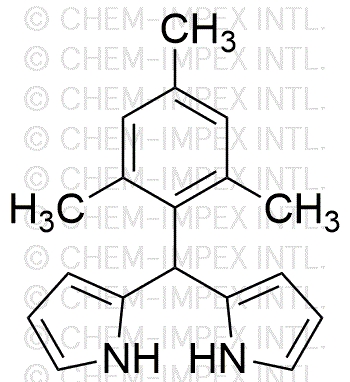5-(Mesityl)dipyrrylmethane is widely utilized in research focused on:
- Organic Electronics: This compound is used in the development of organic light-emitting diodes (OLEDs) and organic photovoltaics, enhancing the efficiency and stability of these devices.
- Fluorescent Probes: Its unique fluorescent properties make it ideal for use as a probe in biological imaging, allowing researchers to visualize cellular processes with high precision.
- Catalysis: The compound serves as a catalyst in various organic reactions, providing a more efficient pathway for chemical transformations compared to traditional catalysts.
- Material Science: It is employed in the synthesis of advanced materials, such as sensors and coatings, which benefit from its stability and functional properties.
- Drug Development: Researchers explore its potential in medicinal chemistry, particularly in designing new pharmaceuticals that target specific biological pathways.
General Information
Properties
Safety and Regulations
Applications
5-(Mesityl)dipyrrylmethane is widely utilized in research focused on:
- Organic Electronics: This compound is used in the development of organic light-emitting diodes (OLEDs) and organic photovoltaics, enhancing the efficiency and stability of these devices.
- Fluorescent Probes: Its unique fluorescent properties make it ideal for use as a probe in biological imaging, allowing researchers to visualize cellular processes with high precision.
- Catalysis: The compound serves as a catalyst in various organic reactions, providing a more efficient pathway for chemical transformations compared to traditional catalysts.
- Material Science: It is employed in the synthesis of advanced materials, such as sensors and coatings, which benefit from its stability and functional properties.
- Drug Development: Researchers explore its potential in medicinal chemistry, particularly in designing new pharmaceuticals that target specific biological pathways.
Documents
Safety Data Sheets (SDS)
The SDS provides comprehensive safety information on handling, storage, and disposal of the product.
Product Specification (PS)
The PS provides a comprehensive breakdown of the product’s properties, including chemical composition, physical state, purity, and storage requirements. It also details acceptable quality ranges and the product's intended applications.
Certificates of Analysis (COA)
Search for Certificates of Analysis (COA) by entering the products Lot Number. Lot and Batch Numbers can be found on a product’s label following the words ‘Lot’ or ‘Batch’.
*Catalog Number
*Lot Number
Certificates Of Origin (COO)
This COO confirms the country where the product was manufactured, and also details the materials and components used in it and whether it is derived from natural, synthetic, or other specific sources. This certificate may be required for customs, trade, and regulatory compliance.
*Catalog Number
*Lot Number
Safety Data Sheets (SDS)
The SDS provides comprehensive safety information on handling, storage, and disposal of the product.
DownloadProduct Specification (PS)
The PS provides a comprehensive breakdown of the product’s properties, including chemical composition, physical state, purity, and storage requirements. It also details acceptable quality ranges and the product's intended applications.
DownloadCertificates of Analysis (COA)
Search for Certificates of Analysis (COA) by entering the products Lot Number. Lot and Batch Numbers can be found on a product’s label following the words ‘Lot’ or ‘Batch’.
*Catalog Number
*Lot Number
Certificates Of Origin (COO)
This COO confirms the country where the product was manufactured, and also details the materials and components used in it and whether it is derived from natural, synthetic, or other specific sources. This certificate may be required for customs, trade, and regulatory compliance.


